
|
Scientific Enlightenment, Div. One
Book 2: Human Enlightenment of the First Axial
2.D.1. The Yijing Metaphysics of Sung Dynasty, China
Chapter 7: The Post-Heaven Yijing Trigram Arrangement
ACADEMY | previous section | Table of Content | next section | GALLERY
|
copyright © 2004, 2006 by Lawrence C. Chin. All rights reserved.
The synthesizing spirit of the Yijing metaphysicians would expectedly unify the grammic representation of the structure of the cosmos with the Yellow River Picture and the Luo River Document which originated from different traditions, by superimposing one on top of the other with conversion. Before showing this we must first be familiarized with the post-heaven arrangement of the trigrams attributed to king Wen, the father of king Wu who defeated the Shang.
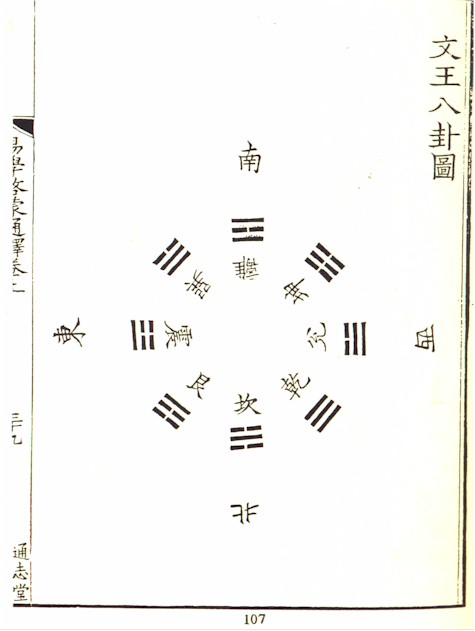 Translation altered from Joseph Adler's of Chuxi. The emperor or Lord [note the character originally means "ancestor"] emerges in Zhen [
Translation altered from Joseph Adler's of Chuxi. The emperor or Lord [note the character originally means "ancestor"] emerges in Zhen [ , turning clockwise], equalizes or regulates in Xun, causes mutual meeting or perception in Li, brings about services in Kun, delights in speech in Dui, battles in Qian, labors or toils in Kan, fulfills speech in Gen. The ten thousand things emerge in Zhen. Zhen is east. [They then] equalize or get regulated [i.e. assume their proper ways, the way they should be] in Xun. Xun is southeast. "Regulation" means the purity and perfection of the ten thousand things. Li means clear [bright]. It is the trigram where all ten thousand things "perceive" each other in the south. The sage faces the south in order to listen [or attend] to the resonance of all under heaven so as to rule. Remember that since Hsia time the royal palace of the ruler invariably faces south, the location of Ultra Yang (in pre-heaven) and so the source of being (in being, that is). Hence this [practice] is taken from this [idea]. Kun means earth. All ten thousand things get nourished thereby. Hence it is said "brings about service in Kun." Dui means autumn equinox [?], and the ten thousand things get pleased or delighted thereby. Hence it is said: [all] delight in speech in Dui. To battle in Qian: Qian is the trigram of northwest. It says of the mutual displacing between ying and yang. Kan means water, the trigram of the established [or true] north, and of labor [or toil], and where the ten thousand things return. Hence it is said: laboring (toiling) in Kan. Gen is the trigram of northeast, where the ten thousand things fulfill their end in order to fulfill their beginning. Hence it is said: fulfilling the speech in Gen. The [universal] Spirit [shen] is that which vitalizes the ten thousand things [to be as they are] so that they may be articulated [as by speech?]. (Joseph Adler's translation: "Spirit (shen) is what is referred to by the 'wondrous' myriad things."] Nothing animates the ten thousand things faster [more forcefully] than thunder; nothing involutes [or scatters] the ten thousand things faster than wind; nothing dries up the ten thousand things more parching than fire; nothing pleases the ten thousand things more than lake; nothing tenderly moistens the ten thousand things more than water. Nothing ends the ten thousand things and commences the ten thousand things more than Gen. Hence water and fire approach mutually, thunder and wind do not oppose each other, and mountain and lake have the [same] stream of air running through them [thereby communicating, sharing the same essence]; thus change and transformation are possible and the ten thousand things can be formed.
, turning clockwise], equalizes or regulates in Xun, causes mutual meeting or perception in Li, brings about services in Kun, delights in speech in Dui, battles in Qian, labors or toils in Kan, fulfills speech in Gen. The ten thousand things emerge in Zhen. Zhen is east. [They then] equalize or get regulated [i.e. assume their proper ways, the way they should be] in Xun. Xun is southeast. "Regulation" means the purity and perfection of the ten thousand things. Li means clear [bright]. It is the trigram where all ten thousand things "perceive" each other in the south. The sage faces the south in order to listen [or attend] to the resonance of all under heaven so as to rule. Remember that since Hsia time the royal palace of the ruler invariably faces south, the location of Ultra Yang (in pre-heaven) and so the source of being (in being, that is). Hence this [practice] is taken from this [idea]. Kun means earth. All ten thousand things get nourished thereby. Hence it is said "brings about service in Kun." Dui means autumn equinox [?], and the ten thousand things get pleased or delighted thereby. Hence it is said: [all] delight in speech in Dui. To battle in Qian: Qian is the trigram of northwest. It says of the mutual displacing between ying and yang. Kan means water, the trigram of the established [or true] north, and of labor [or toil], and where the ten thousand things return. Hence it is said: laboring (toiling) in Kan. Gen is the trigram of northeast, where the ten thousand things fulfill their end in order to fulfill their beginning. Hence it is said: fulfilling the speech in Gen. The [universal] Spirit [shen] is that which vitalizes the ten thousand things [to be as they are] so that they may be articulated [as by speech?]. (Joseph Adler's translation: "Spirit (shen) is what is referred to by the 'wondrous' myriad things."] Nothing animates the ten thousand things faster [more forcefully] than thunder; nothing involutes [or scatters] the ten thousand things faster than wind; nothing dries up the ten thousand things more parching than fire; nothing pleases the ten thousand things more than lake; nothing tenderly moistens the ten thousand things more than water. Nothing ends the ten thousand things and commences the ten thousand things more than Gen. Hence water and fire approach mutually, thunder and wind do not oppose each other, and mountain and lake have the [same] stream of air running through them [thereby communicating, sharing the same essence]; thus change and transformation are possible and the ten thousand things can be formed.
Zhaozi says this clarifies the eight trigrams of king Wen. He furthermore says: Perfect indeed! The reason why king Wen constructed [this] yi is to obtain [the principle of] the functioning of heaven and earth. Hence the intercourse of Qian and Kun results in Tai.["peace"] I.e.  on top of
on top of  , the last (the eighth) of the Ultra Yang hexagrammic series (with Qian as base), the uttermost lower left (northeast) in the square diagram or the beginning of summer or 9 AM in the circle diagram. The intercourse of Kan and Li results in Zhiji ["after completion"]. Namely,
, the last (the eighth) of the Ultra Yang hexagrammic series (with Qian as base), the uttermost lower left (northeast) in the square diagram or the beginning of summer or 9 AM in the circle diagram. The intercourse of Kan and Li results in Zhiji ["after completion"]. Namely,  on top of
on top of  , or the sixth of the third row from the bottom up in the square diagram (the first of the Lesser Ying hexagrammic series, with Li as the base). In the circle diagram it is the first month of the year or 4am. Qian is born at zi, i.e. 11 PM or the winter solstice. Kun is born at noon. Kan ceases at yen, or the beginning of spring or 3 AM. Li ceases at shen or 3 PM or the beginning of autumn. In order to resonate with the timings [like kairos? seasons] of Heaven. Rather than Ultra Yang with Qian and Ultra Ying with Kun in the pre-heaven arrangement, the Lesser Ying in its representative Li and the Lesser Yang with its Kan thus play the pivotal roles in the post-heaven trigrammic, governing the north-south (in the spatial) or winter-summer (in the temporal) axis, before or after which are then Qian and Kun located in the now subordinate positions. Qian being set at northwest and Kun retiring to southwest, the elder son now performs the functions [of the family in the microscopic, familial realm] and the elder daughter replaces the mother [in the latter's functions]. Kan and Li obtain the positions [formerly reserved for Qian and Kun] and Dui and Gen [the ying of Ultra Yang and the yang of Ultra Ying] situate themselves in the corners [Adler: "they are paired"] in order to [cor]respond to the directions [i.e. the domains] of Earth [space]. A model of kingship "was King Wen." He epitomized it in this. The theme of concentric politea -- microcosmos recapitulating macrocosmos -- thus leads to the understanding that the pre-heaven structure of the cosmos corresponds to pre-reproductive union of the parents and that the post-heaven to the post-reproductive, i.e. when the offspring grow up to replace the parents in functions.
, or the sixth of the third row from the bottom up in the square diagram (the first of the Lesser Ying hexagrammic series, with Li as the base). In the circle diagram it is the first month of the year or 4am. Qian is born at zi, i.e. 11 PM or the winter solstice. Kun is born at noon. Kan ceases at yen, or the beginning of spring or 3 AM. Li ceases at shen or 3 PM or the beginning of autumn. In order to resonate with the timings [like kairos? seasons] of Heaven. Rather than Ultra Yang with Qian and Ultra Ying with Kun in the pre-heaven arrangement, the Lesser Ying in its representative Li and the Lesser Yang with its Kan thus play the pivotal roles in the post-heaven trigrammic, governing the north-south (in the spatial) or winter-summer (in the temporal) axis, before or after which are then Qian and Kun located in the now subordinate positions. Qian being set at northwest and Kun retiring to southwest, the elder son now performs the functions [of the family in the microscopic, familial realm] and the elder daughter replaces the mother [in the latter's functions]. Kan and Li obtain the positions [formerly reserved for Qian and Kun] and Dui and Gen [the ying of Ultra Yang and the yang of Ultra Ying] situate themselves in the corners [Adler: "they are paired"] in order to [cor]respond to the directions [i.e. the domains] of Earth [space]. A model of kingship "was King Wen." He epitomized it in this. The theme of concentric politea -- microcosmos recapitulating macrocosmos -- thus leads to the understanding that the pre-heaven structure of the cosmos corresponds to pre-reproductive union of the parents and that the post-heaven to the post-reproductive, i.e. when the offspring grow up to replace the parents in functions.
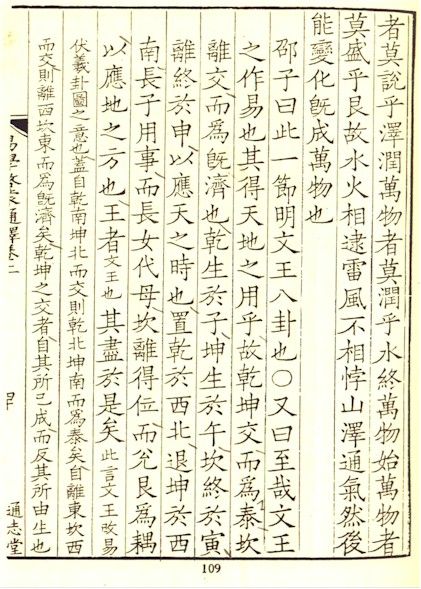
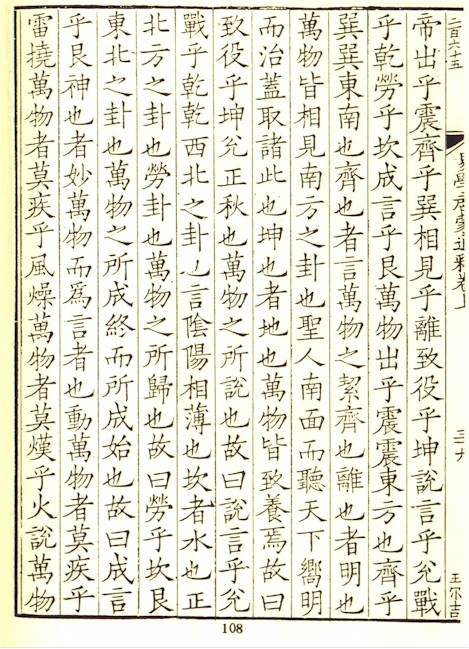
This speaks of King Wen modifying the intention [meaning] of Fu-hsi's trigrammic chart. Thus from the intercourse between Qian in the south and Kun in the north follow Qian in the north and Kun in the south, giving rise to Tai. From the intercourse between Li in the east and Kan in the west follow Li in the west and Kan in the east, giving rise to Zhiji. The combination of Qian and Kun proceeds from their completion but results in their reversion to where they came from. In the explanatory diagram below, this is stage II, the mirror image reversal of the pre-heaven arrangement (stage I). Change again, and Qian retreats to the northwest, and Kun to the southwest. The directions of this secondary change are indicated in stage III, to result in the post-heaven arrangement (stage IV). The change of Kan and Li is from the east upward to the west and from the west downward to the east. Hence after the retreat of Qian and Kun, Li obtains the position of Qian and Kan that of Kun. From stage I straight to stage IV. The transition of power, so to speak, from the Ultras to the Lessers is completed. Zhen which performs the function [i.e. substituting for the father] takes place in the east, Xun substituting for the mother grows and nourishes in the southeast.
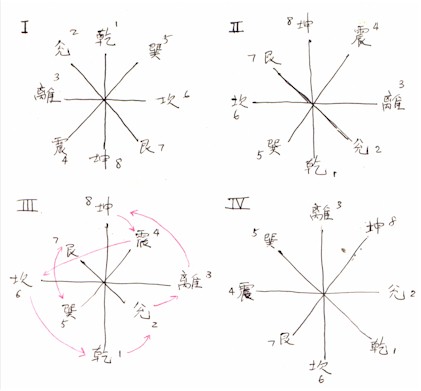
The small print commentary explains that to intercourse Qian at noon has to cross over to midnight (the reverse of where it came from) and so does Kun (mirror image reversal). A second change results in their respective retreat to the northeast and the southeast. It explains the same for Kan and Li, first the mirror image reversal, then the taking-over of the north-south central axis. The pre-heaven [scheme] is dominated by the intercourse between Qian and Kun and between Kan and Li. All the dominant one of the pairs of Ultra Yang, Ultra Ying, Lesser Yang and Lesser Ying: the yang of Ultra yang and the ying of Ultra Ying, and the yang of Lesser Ying and the ying of Lesser Yang. These intercourses are about to result in change but no fixed positioning: the timing [seasons?] of heaven inexhaustible. Hence is said "resonating with Heaven". The post-heaven is dominated by the change among Kan, Li, the dominants of Lesser Yang (its ying) and Lesser Ying (its yang), Zhen, and Dui, the subordinates of these (ying of Lesser Ying and yang of Lesser Yang), whose intercourses do not result in change but in fixed positioning. The directions of earth are thus constant. The idea is that heaven, changing, revolves around earth which is fixed in place: the geocentric view. Hence is said "resonating with Earth". It is explained that in pre-heaven, Qian is the authority but in the post-heaven the authority passes to Zhen. Qian is the father of Zhen and Zhen the son of Qian. The switch of "functioning" (of the cosmos) from the main, north-south axis of Qian-Kun to the secondary, east-west axis of Kan-Li now assuming the vertical axis means also the passage of authority from South of the vertical to actually East of the horizontal. Zhen and Dui begin the intercourse; therefore they are placed in the positions of morning and evening. Ken and Li intercourse to the utmost; therefore they are placed in the positions of midnight and noon. Xun and Gen do not intercourse, but their ying and yang are still mixed; therefore they are placed on the sides among the functioning [trigrams] [rising toward sunlight]. Qian and Kun are pure yang and pure ying, and so are placed in non-functioning positions [declining toward midnight].
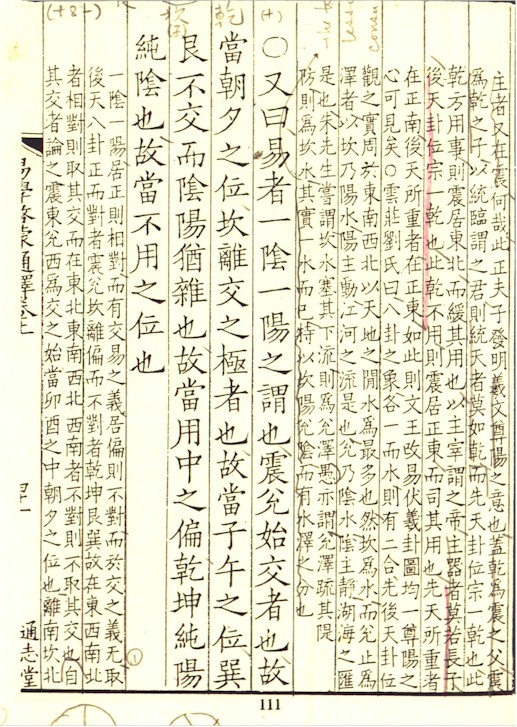
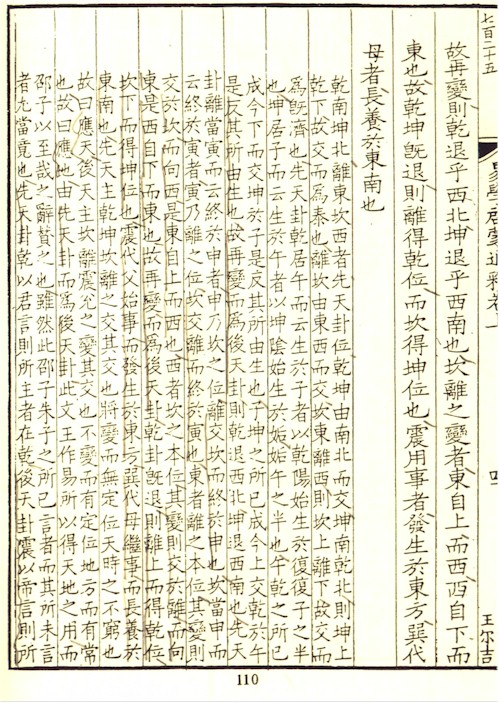
Neo-Confucianism, which lies behind the construction of yijing cosmology, incorporates Daoism (and Buddhism as well), and, seeing thus yijing cosmology as explicating the inner structure of Dao, expresses the Daoist principle "Reversal is the movement of Dao" with the alternation from (between?) pre- to (and?) post-heaven. " Hsi-tzu A.5.1: 'The alternation of yin and yang is what is meant by the Way [Dao].'" (Joseph Adler, ibid.) In the same way, the dominant axis of the original (pre-heaven) cosmogonic differentiation, the vertical, must give way to the subordinate, the horizontal, i.e. the axis of Ultras giving way to that of Lessers. In the second round the originally horizontal becomes the vertical. The dominant principle of order (politea) of the functional perspective, remember, the recapitulation of the macroscopic by the microscopic (or what Eric Voegelin calls the anthropological or macroanthropic [of Hellas]), which also underlies the recapitulation of the cosmic by the moral, allows the familial situation of descent to be manifestation of this alternative movement of the Dao, i.e. of the cosmic order of things (politea). Again, what Joseph Adler refers to as "the connection between the moral order and the natural order" fundamental to Confucianism or "the inherence of moral order within the natural order" is not arbitrary extrapolation but necessary within that particular functional perspective called the anthropological, i.e. functional perspective following the second mode.
In this connection, therefore, we understand the purpose for the transition from the pre- to the post-heaven. Zhen and Dui horizontally and the Six Trigrams vertically are the functioning of Change. [Ts'ai YŁan-ting:] Having examined this chart, I would explain it further. As for Zhen in the east and Dui in the west: Yang's main function is to progress, so we take the elder as prior and place him on the left. Ying's main function is to retire, so we take the younger as honored and place her on the right. As for Kan in the north: it is in the middle of progressing. Li in the south is in the middle of retreating. The male in the north and the female in the south shelter each other's domiciles. These four are all placed in the four cardinal positions, and are the function-performing trigrams. However, Zhen and Dui initiate, and Kan and Li complete. Zhen and Dui are light and Kan and Li are heavy. Qian in the northwest and Kun in the southwest are father and mother, already old and retired, occupying the non-functioning places. However, the mother is intimate and the father is noble. Therefore Kun is like half-functioning, and Qian completely non-functioning.
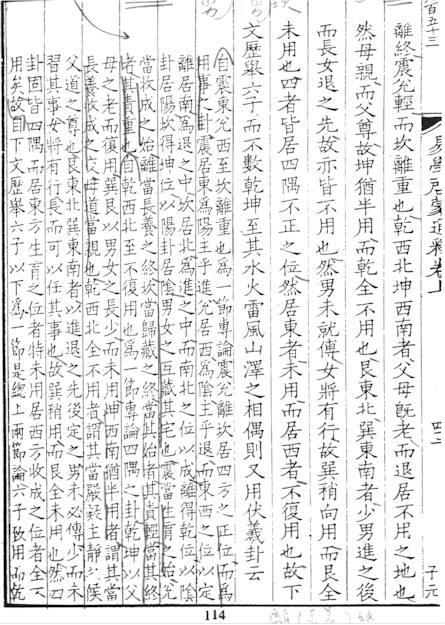
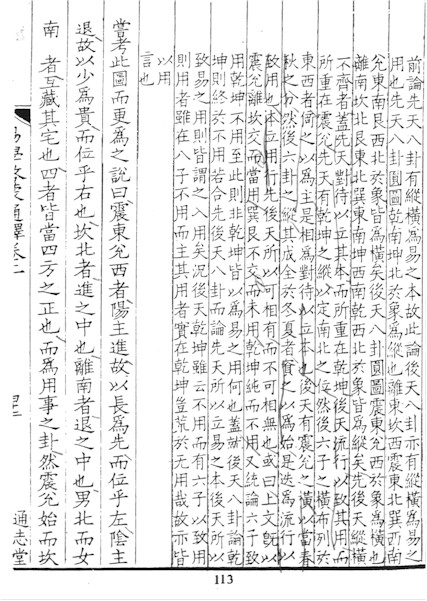
Gen in the northeast and Xun in the southeast are the youngest male after his advancement and the oldest female before her retiring. Therefore they also are both non-functioning. However, the male has not yet been taught, and the female is about to travel [i.e. leave home to be married]. Therefore Xun has a slight tendency toward functioning, while Gen is completely non-functioning. The four all occupy the non-cardinal positions in the four corners. However, the occupants of the East [the youngest son and the oldest daughter] are not yet functioning, while the occupants of the West [the father and the mother] are no longer functioning. Therefore the text below successively brings out the six children but does not count Qian and Kun. When we come to the pairing of water and fire, thunder and wind, mountain and marsh, then we will again use Fu-hsi's version of the trigrams....
乾天也, 故稱乎父;
坤地也, 故稱乎母. 震一索而得男, 故謂之長男.
巽一索而得女, 故謂之長女. 坎再索而得男, 故謂之中男. 離再索而得女, 故謂之中女. 艮三索而得男, 故謂之少男.
兌三索而得女, 故謂之少女.
... 坤求於乾, 得其初九而為震, 故曰一索而得男.
乾求於坤, 得其初六而為巽, 故曰一索而得女,
坤再求,
而得乾之九二, 以為坎, 故曰再索而得男;
乾再求, 而得坤之六二, 以為離, 故曰再索而得女.
坤三求,
而得乾之九三, 以為艮, 故曰三索
而得男; 乾三求,
而得坤之六三, 以為兌, 故曰三索而得女 Qian is Heaven; therefore it is designated father. Kun is Earth; therefore it is designated mother. In Zhen [she] first tries to obtain a son; therefore it is called the eldest son. In Xun [the father] first tries to obtain a daughter; therefore it is called the eldest daughter. In Kan [she] again tries to obtain a son; therefore it is called the middle son. In Li [he] again tries to obtain a daughter; therefore it is called the middle daughter. In Gen [she] for the third time tries to obtain a son; therefore it is called the youngest son. In Dui [he] for the third time tries to obtain a daughter; therefore it is called the youngest daughter... In the present passage Kun seeks in Qian to obtain the 9 in the first place, making Zhen. [Adler explains: "'9 in the first place' means a yang line in the first (bottom) position of the hexagram."] Thus "[The mother] first tries to obtain a son." Qian seeks in Kun to obtain the 6 in the first place, making Xun. Thus "[The father] first tries to obtain a daughter." Kun again seeks to obtain a 9 from Qian in the second place, thereby making Kan. Thus "[She] again tries to obtain a son." Qian again seeks to obtain a 6 from Kun in the second place, thereby making Li. Thus "[He] again tries to obtain a daughter." Kun for the third time seeks to obtain a 9 from Qian in the third place, thereby making Gen. Thus "[She] for the third time tries to obtain a son." Qian for the third time seeks to obtain a 6 from Kun, in the third place, thereby making Dui. Thus "[He] for the third time tries to obtain a daughter." The progression of the yang line from bottom through middle to top indicates elder, middle, and youngest son, and the same movement of ying line, elder, middle, and youngest daughter. Below the post-reproductive family structure, recapitulating the post-heaven cosmic structure. Note the axis of oppositional symmetry-conservation, mother-youngest son, father-elder daughter, etc. Here what the contemporary feminists would regard as the ideology of patriarchal oppression as rooted in the family was apparently the result of humans in the functional (still the cosmological) perspective attempting to harmonize their social order (here in the familial aspect) with the cosmos through micro-macro-cosmic recapitulation. Thus, once again, it must be noted that the feminist sensibility is possible only in (the beginning of) the structural perspective when the cosmological perspective has disintegrated and sunk into "untruth", "lie" (psuedo), in the words of Eric Voegelin.
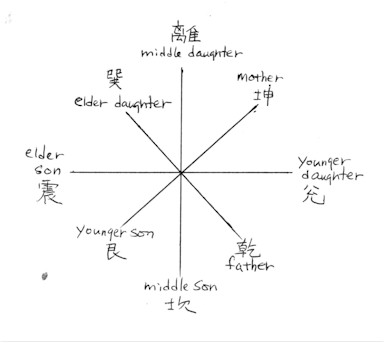
The second point to be noted is that with the post-heaven arrangement the original conservational symmetry of each axis in the pre-heaven is broken. Only the vertical 6-3 retains the original mirror image symmetry, conserving 4 + 5 = 9 (yang = 1 and ying = 2). Axis 7-8 (Gen and Kun) gives 6 + 5 = 11; axis 2-4 gives 4 + 5 = 9, but Zhen and Dui are not mirror images of each other. Axis 1-5 gives 3 + 4 = 7. The total number of the post-heaven trigrammic of course is conserved, i.e. remains the same as in pre-heaven. The situation is therefore very similar to the CPT symmetry-breaking during the Big Bang which gives rise to the arrow of time and the predominance of matter over anti-matter that make our existence possible. The symmetry of each individual C, P, and T is broken, although their brokenness together conserves the original. This is not to suggest that yijing metaphysics prefigures modern cosmology, but that, given the necessary principle of conservation and the symmetry of (as) order of the cosmos as the result of it, the switch from one configuration to another is only possible by breaking the original symmetry of individual axes but conserving the whole amount. Again, the necessary Conservation has so tremendously limited the possible means for change that the parallel between philosophy and modern physics is no longer surprising.
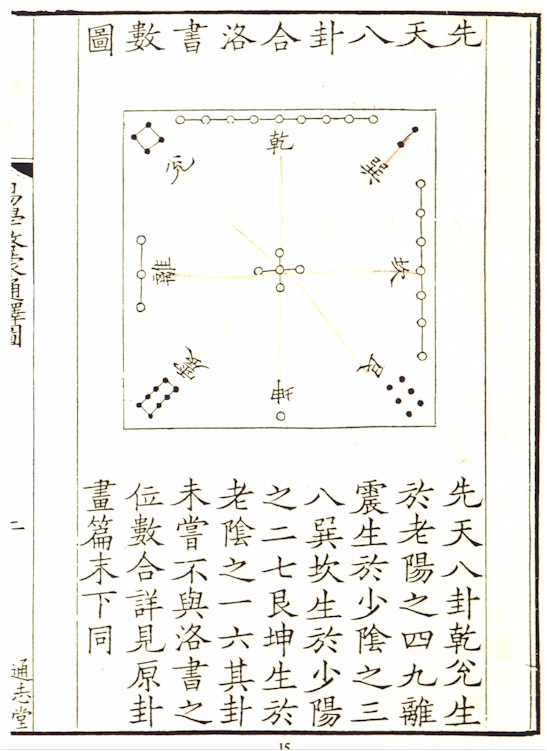
|
For the sake of symmetry -- the necessity of the pairing of the opposites -- the pre-heaven arrangement of the trigrams representing the structure of the cosmos is to be superimposed on the Luo River Document since this magic square is supposed to be post-heaven. The pre-heaven numerals of spatial privilege (red) are thus converted to those of the magic square (dark) at the same representational position.
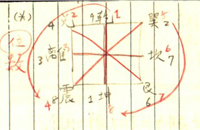
The 8 trigrams of the pre-heaven: Qian and Dui are generated from the 4-9 of Ultra Yang; Li and Zhen from 3-8 of Lesser Ying; Xun and Kan from the 2-7 of Lesser Yang; Gen and Kun from the 1-6 of Ultra Ying. The trigrams thus mesh with the positions and numbers of the Luo River Document.
|
Thus the correspondence between the trigrammic numerology and the magic square is obtained by subtracting the cosmological constant (the [minimal] constant of being) 5 from the intensity of existence of each of the 4 Hsiangs (duo-grams): The ying-yang variants of Ultra Yang (the addition of the 2 Yis on top of it), localized on top left of the map of the structure of the cosmos, can be converted to the 9 and 4 of the corresponding location of the map of magic square. Lesser Ying, whose ying-yang variants are Zhen and Li, respectively, has its intensity of existence 8 subtracted by the constant 5 to get the 3-8 for its corner of middle and lower left. Same with Lesser Yang and Ultra Ying. This seems ingeniously contrived, but the important point is not the argument over its artificialness but its experiential motivation in the spirit of synthesis and conservational symmetry.
Symmetry then requires the superposition of the post-heaven trigrammic representation of king Wen on the Yellow River Diagram which is pre-heaven.
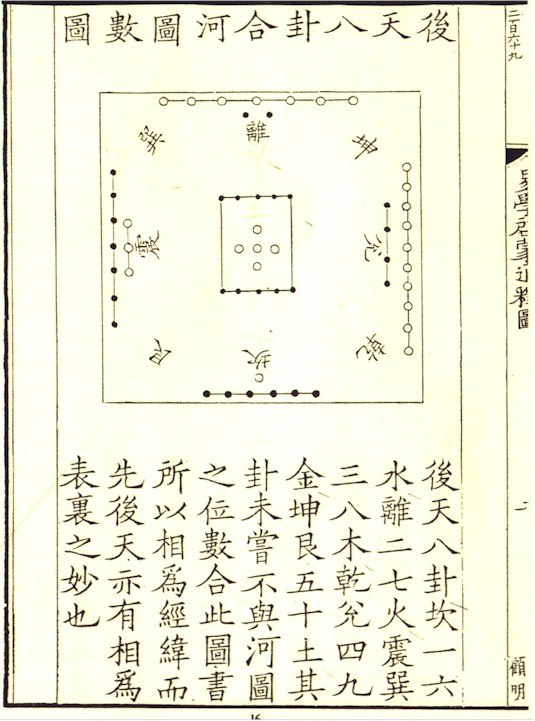 |
The 8 trigrams of the post-heaven: Kan 1-6 is water; Li 2-7 is fire; Zhen and Xun 3-8 is wood; Qian and Dui 4-9 is metal; Kun and Gen 5-10 [across the diagonal from upper right to lower left] is earth. Thus the trigrams mesh with the positions and numbers of Yellow River Picture. These picture and document henceforth together constitute the longitude and latitude and the pre- and post-heaven; they mutually complete each other and show the amazingness of the interior-exterior.
This is therefore how the numerological representation of the genesis of cosmic elements can be unified with the numerological charting and also the trigrammic representation: three different traditions in one. Heaven (south, top) sends 1 down to Earth (north, bottom) and the Earth completes it with 6: when the constant of being 5 is conserved as the excess of yang is evened out by the deficiency of ying in their integration, the element appears, water, in the north with ying since it is cold, dense, etc. The Earth sends 2 up to Heaven (south, top) and Heaven receives it with 7, the conservation of 5 resulting in fire, an yang-element, hot, rare, and so in the south and with summer. Heaven then sends 3 to the east (Lesser Ying) where Earth receives and completes it with 8, with 5 obtaining wood, in the east, and so on.
|
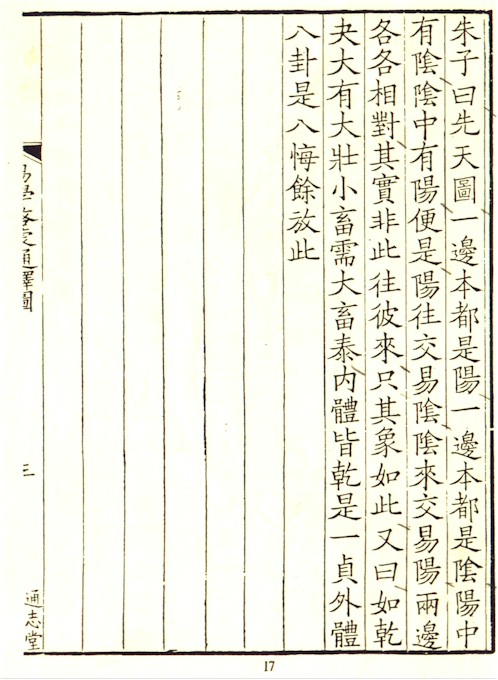
|
In conclusion, a remark on the pre-heaven trigrammic arrangement.
Zhuzi says, the pre-heaven picture has one side entirely of yang and another entirely of ying. In the pre-heaven trigrammic arrangement, Qian (1), Dui (2), which derive from Ultra Yang, and Li (3) and Zhen (4), which derive from Lesser Ying, all have yang as base (the lowest line), and all are located on the left half; and Xun (5) and Kan (6) which derive from Lesser Yang, Kun (8) and Gen (7) which derive from Ultra Ying, all have ying as the bottom-most and are all located on the left half. Yang has ying inside and ying has yang inside; hence yang comes to intercourse with ying and ying with yang. The two sides are in mutual oppostion. But in fact it is not such as this going and that coming; this is only the appearance (hisang, image).
The transition to the post-heaven is as has been explained.
|

 Translation altered from
Translation altered from 










